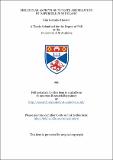Files in this item
Molecular aspects of nitrate assimilation in 'Aspergillus nidulans'
Item metadata
| dc.contributor.advisor | Kinghorn, Jim | |
| dc.contributor.author | Hawker, Kim Lorraine | |
| dc.coverage.spatial | 216 p. | en_US |
| dc.date.accessioned | 2018-06-12T14:53:04Z | |
| dc.date.available | 2018-06-12T14:53:04Z | |
| dc.date.issued | 1991 | |
| dc.identifier.uri | https://hdl.handle.net/10023/13970 | |
| dc.description.abstract | The crnA gene of A.nidulans is confirmed to encode a transport protein, possibly for nitrate. The single open reading frame of 1449 nt encodes a polypeptide of 483 AAs with a molecular weight of 51,769 Da. The high percentage of clustered apolar AAs suggests a membrane protein with ten membrane spanning domains. No similarity between the crnA encoded polypeptide and those of other transport genes or any other gene was observed. The regulation of the A.nidulans nitrate transporter was investigated by studying levels of mRNA transcribed from the crnA gene. The crnA cDNA hybridised to two mRNAs on Northern blots. The 1.8 kb message corresponding to the size of the crnA gene is inducible with nitrate and nitrite. The 1.1 kb, constitutively synthesized message is believed to be a second transcript from the crnA gene rather than from a gene elsewhere in the genome. The expression of the crnA gene, determined from Northern blotting experiments, is shown to be at the level of mRNA accumulation. A requirement for both positive acting regulatory genes, areA and nirA is observed. The expression of the niiA and niaD genes, encoding nitrite reductase and nitrate reductase respectively, is shown to be regulated at the level of mRNA accumulation by a mechanism involving both the areA and nirA gene products. In addition, the nitrate reductase apoenzyme influences the expression of all three structural genes crnA, niiA and niaD. This effect is also exerted at the level of mRNA accumulation. Sequences upstream of the niaD and niiA genes from Aspergillus oryzae, A.nidulans and A.niger were compared, in addition to a similar region of the crnA gene. In particular, one sequence of ten nucleotides was found to share substantial similarity between each gene. It is possible that this motif is a cis-acting transcription factor recognised by a regulatory protein. The consensus TATCTA, a possible receptor site for the areA gene product, was identified several times upstream of each gene. The nit-4: gene of Neurospora crassa is shown to complement the A.nidulans nirA loss of function mutant via genetic transformation. The three transformant strains each have multiple integrates of the nit-4 gene, although none are present at the homologous site. The regulation of A.nidulans nitrate reductase by the N.crassa nit-4 gene is observed to be essentially normal, i.e. wild type. | en_US |
| dc.language.iso | en | en_US |
| dc.publisher | University of St Andrews | |
| dc.subject.lcc | QH601.N5H2 | en |
| dc.subject.lcsh | Membranes (Biology) | en |
| dc.title | Molecular aspects of nitrate assimilation in 'Aspergillus nidulans' | en_US |
| dc.type | Thesis | en_US |
| dc.contributor.sponsor | Science and Engineering Research Council (SERC) | en_US |
| dc.type.qualificationlevel | Doctoral | en_US |
| dc.type.qualificationname | PhD Doctor of Philosophy | en_US |
| dc.publisher.institution | The University of St Andrews | en_US |
This item appears in the following Collection(s)
Items in the St Andrews Research Repository are protected by copyright, with all rights reserved, unless otherwise indicated.

